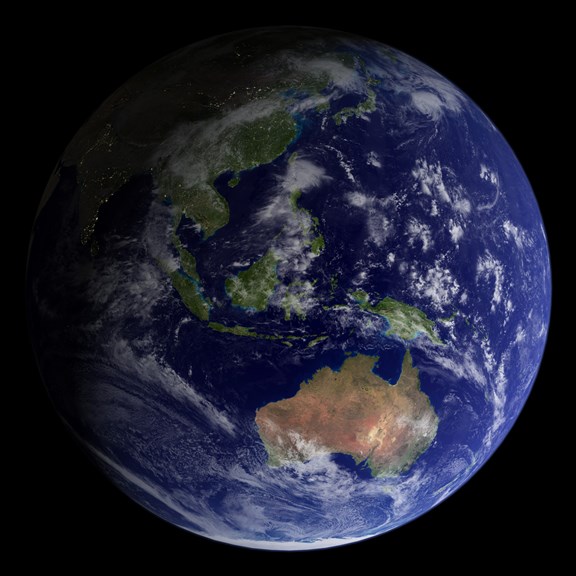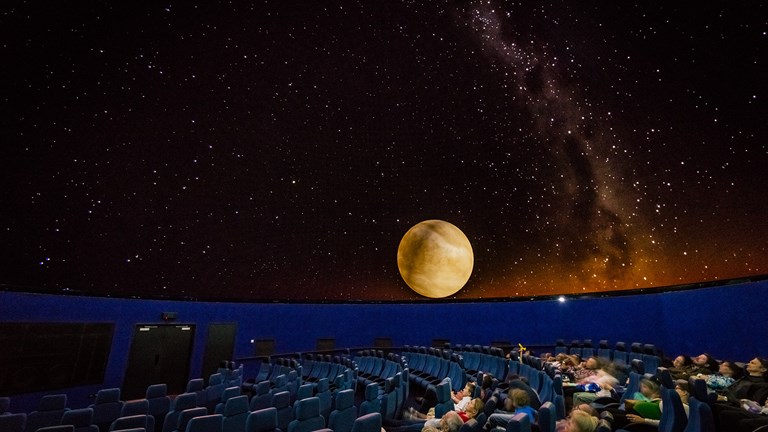
Planetarium Nights
Experience science and art in an evening of immersive cinema for adults 18 years and over.


Experience science and art in an evening of immersive cinema for adults 18 years and over.

Explore the universe and discover the night sky in comfort under the big dome.
Winter Solstice is on Friday 21 June. On this day in the southern hemisphere the sun rises and sets at its most northerly points on the horizon, its path across the sky is lowest, and it is the shortest day of the year.
| Date | Rise / Solar noon* / Set (day length) |
|---|---|
| Tue 1st | 7.26am / 12.17pm / 5.09pm (9.42 hrs) |
| Fri 11th | 7.32am / 12.19pm / 5.07pm (9.35 hrs) |
| Mon 21st | 7.35am / 12.21pm / 5.08pm (9.32 hrs) |
| Wed 30th | 7.36am / 12.23pm / 5.11pm (9.34 hrs) |
*When the Sun is at its highest crossing the meridian or local longitude.
| Phase | Date |
|---|---|
| Third Quarter | Wed 2nd |
| New Moon | Thu 10th |
| First Quarter | Fri 18th |
| Full Moon | Fri 25th |
This month’s Moon apogee (furthest from Earth) is on Wed 8 at 406,228 km and perigee (closest to Earth) is on Wed 23 at 359,956 km
Mercury is not easily seen this month as it lies very close to the sun.
Venus could be seen in the early evening twilight from around 5.30pm in the north-west but will set by 6.30pm.
Earth has its June or mid-year solstices this month; winter solstice for the southern hemisphere and summer solstice for the northern hemisphere. Solstice comes from the Latin sol (sun) and sistere (stand still). The sun makes its most northerly, shortest and lowest daily path in the sky reaching its winter limit as seen from the southern hemisphere. On this shortest day of the year, the sun’s rays reach the ground at their shallowest angle (hence long shadows) and give the least energy per square metre.
Mars remains visible low in the north-west in the evening but will set by around 8pm.
Jupiter will rise in the east from 11pm and can be seen throughout the night as it traverses the northern sky before fading in the dawn light in the north-west shortly before 7am.
Saturn rises in the east around 10pm, moves in a low arc across the north after which it will be lost in the west in the early morning light.
There are minor meteor showers this month centred in Scorpius and Sagittarius, and The Bootids can also appear from very late June into early July. Although low in number (less than 10 per hour) they can often be spectacular and bright with many displaying a yellow/orange colour. The best time to see meteors is after midnight with no moon in the night sky.
While Orion disappears below the western horizon (with the ‘Saucepan’ asterism), his two dogs Canis Major with the star Sirius and Canis Minor with the star Procyon both remain visible in the west and north-west respectively.
Leo the lion is still visible in the north with the bright star Regulus. Look for a large hook of stars, or inverted question mark, to locate his curving mane and shoulders.
This month Scorpius is fully visible in the south-east with the red-giant star Antares as the middle of three stars that form the scorpion’s body. As we enter winter Sagittarius the archer begins to rise in the east after Scorpius with the centaur’s bow and arrow also the famous ‘Tea Pot’ asterism leading the way. You could imagine tea being poured from its spout into the curving tail of the nearby Scorpion.
The Southern Cross or Crux is higher in the south this month with the Pointers (Alpha and Beta Centauri) a little lower down in the south-east. Visible from darker locations are the two neighbouring galaxies that sit as two small fuzzy patches in the south-west, the Large and Small Clouds of Magellan. For viewers in our southern latitudes they are a special sight as they cannot be seen from equivalent latitudes in the northern hemisphere.
Also visible in less light-polluted skies in the evening is the broad band of the Milky Way stretching across the night sky from south-east to north-west. This concentration of hundreds of billions of stars also contains numerous interstellar dust clouds which appear as dark areas and which block starlight reaching us from more distant stars of the galaxy.
For evening viewing during winter we have six of the traditional western constellations of the zodiac spread across the night sky. Low in the south-east Sagittarius is rising over the horizon while Scorpius is higher in the south-east. Turning left there is Libra in the north-east, Virgo to the north, Leo in the north-west and Cancer lower in the north-west.
In the Boorong tradition of north-west Victoria the brightest star in the night sky (Sirius high in the west) marks the head of Warepil the wedge-tailed eagle with lesser stars either side forming wings. As the largest bird of prey in Australia these eagles represent some of the most important ancestral beings and guardians of the people, the animals and plants, and the land.
Along the band of the Milky Way and formed from several dark regions is the large emu Tchingal whose legs, body and neck stretch from the near the south-eastern horizon up to a dark head (the Coal Sack). Next to the emu’s head is Bunya the possum who is sitting high in a tree (the Southern Cross).
In a colourful Boorong story the giant emu was vicious, dangerous and greatly feared. However, the warrior Bunya, failing to kill or even scare off the emu, took fright himself and sought safety high in a tree just out of reach of Tchingal’s lethal beak. Afraid the emu might return, but not knowing it had been killed by others, he stayed where he was. For his cowardice Bunya became the possum that only emerges at night, remains in the trees, and is always on the lookout for danger.
In the south-west are Kourtchin, two majestic brolgas dancing in the sky. Their bodies are the Clouds of Magellan with their long necks, legs and wings formed from many stars around them.
Australia has a rich and varied tradition of aboriginal night sky observing going back tens of thousands of years. Find out more at:
Australian Aboriginal Astronomy
www.aboriginalastronomy.com.au
ISS orbits every 90 minutes at an average distance of 400 km appearing like a bright star moving slowly across the night sky. Here are some of the brightest passes expected this month over Melbourne and Central Victoria:
Tuesday 8th 6.21am–6.26am South-West to East-North-East
Friday 11th 5.38am–5.40am North-North-East to North-East
Sunday 20th 6.20pm–6.25pm North-West to East-South-East
Wednesday 23rd 5.34pm–5.41pm North-West to South-East
For predictions go to:
1st 2002, Czech Republic becomes the first country to ban light pollution.
2nd 1966, Surveyor 1 (USA) reaches the Moon as first probe to land on another body.
3rd 1965, Ed White takes America’s first spacewalk as part of Gemini IV.
6th 1971, Soyuz 11 (‘Union’ 11, USSR) carries the first people to a space station (Salyut 1 or ‘Salute’ 1).
7th 1879, Joan Voute proves with parallax that dwarf star Proxima Centauri is the same distance as Alpha Centauri binary.
8th 2004, a Transit of Venus is observed, the first in 122 years.
9th 1986, Rogers report on Space Shuttle Challenger explosion reveals solid rocket booster fault and serious management and safety problems with US program.
10th 2003, launch of Mars Exploration Rover Spirit (USA) which lands in 2004 and exceeds expectations operating to 2010.
13th 1983, Pioneer 10 (USA) becomes the first spacecraft to travel beyond the planets of the Solar System.
13th 2010, Hyabusa (Japan) craft returns the first asteroid samples to Earth.
14th 1962, European Space Research Organisation (ESRO) begins, later to be part of the European Space Agency (ESA).
15th 763 BCE, Assyrians record a total solar eclipse which helps date other events in Mesopotamian history.
16th 1911, a meteorite weighing 772g strikes a barn in rural Wisconsin (USA).
16th 1963, Valentina V. Tereshkova (USSR) becomes the first woman in space in Vostok 6, the first civilian into space, and the only woman to undertake a solo space flight.
17th 1969, Venera 6 (‘Venus 6’, USSR) descends into Venus’ dense atmosphere sending data before being crushed by rising pressure.
18th 1983, Sally Ride becomes the first American woman in space aboard Shuttle Challenger.
20th 1990, Asteroid Eureka found as part of the Trojans asteroid group orbiting at Mars’ L5 Lagrange point.
21st 2004, SpaceShipOne (USA) is launched as the first privately-funded human space flight.
21st 2006, Pluto’s small moons Nyx and Hydra are named.
22nd 1633, Galileo recants his sun-centred solar system model under threat of torture by the Catholic Inquisition.
22nd 1978, Dr James W. Christy (USA) discovers Pluto’s large moon Charon.
Month Highlights Winter Solstice is on Friday 21 June. On this day in the southern hemisphere the sun rises and sets at its most northerly points on the horizon, its path across the sky is lowest, and it is the shortest day of the year.
24th 1883, discoverer of cosmic rays, Victor Francis Hess, is born.
24th 1915, birth of Fred Hoyle, who later explains the creation of elements in stars, promotes the steady state model of the universe, and coins the pejorative term ‘big bang’ for the rival model of the universe’s creation.
24th 1997, first life-threatening space collision occurs as Russia’s Progress supply craft collides with Mir Space Station during a test docking while not using its automated docking and radar system. The ageing problem-plagued station suffers a 3cm puncture in its Spekr module which quickly depressurises. US astronaut Mike Foale evacuates from the damaged module in time and Mir spins out of control as solar power is lost. Progress rebounds but is later safely de-orbited to burn up. Control is slowly regained by cosmonaut Vasily Tsbliev assisted by cosmonaut Aleksander Lazitkin and Foale. This serious incident heightens tensions between the American space agency NASA and their Russian counterpart Roscosmos.
29th 1818, Angelo Secchi born, one of the first astronomers to believe the Sun is a star.
29th 1961, first use in space of a radioisotope thermoelectric generator (RTG) using plutonium238 which powered a US Navy NAVSAT satellite Transat4A.
29th 1995, Space Shuttle Atlantis (USA) – first docking at Russia’s Mir Space Station.
30th 1908, The Tunguska Event; a meteor several metres in size explodes over Tunguska (Russia) destroying 2,200 km2 of forest in a multi-megaton blast.
30th 1971, Soyuz 11 (USSR) is the only mission to visit the first space station Salut 1 (USSR) after which its crew of three become the only humans known to have died in space when their cabin depressurises prior to or during re-entry.
We are making improvements to our website and would love to hear from you about your experience. Our survey takes around 10 minutes and you can enter the draw to win a $100 gift voucher at our online store!
Museums Victoria acknowledges the Wurundjeri Woi Wurrung and Boon Wurrung Bunurong peoples of the eastern Kulin Nations where we work, and First Peoples across Victoria and Australia.
First Peoples are advised that this site may contain voices, images, and names of people now passed and content of cultural significance.